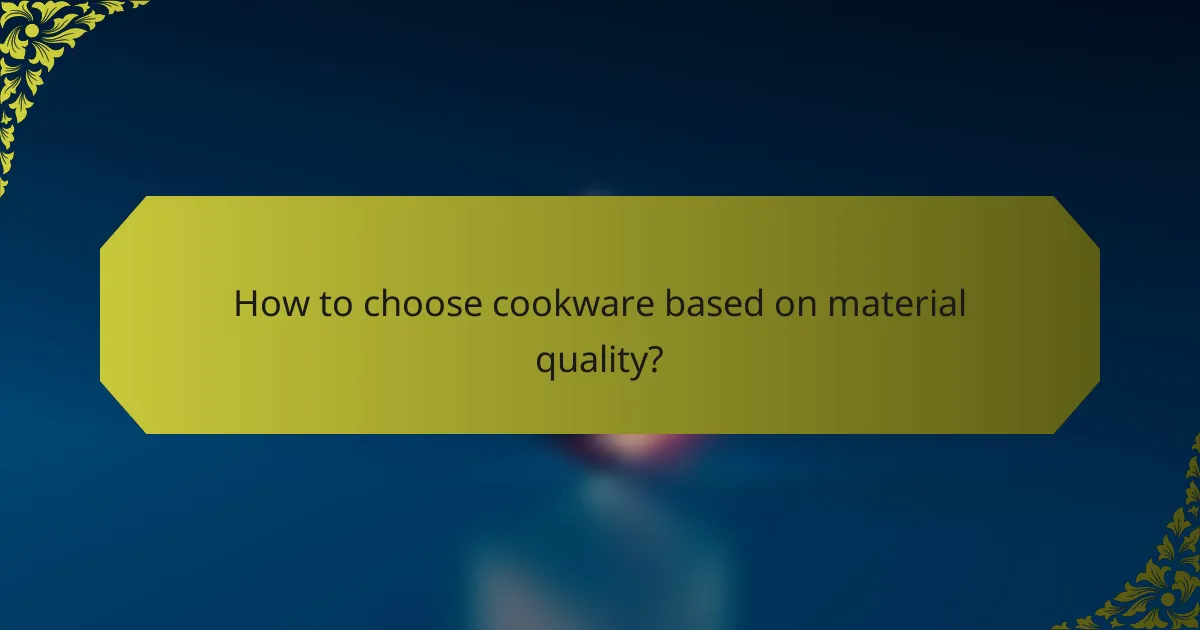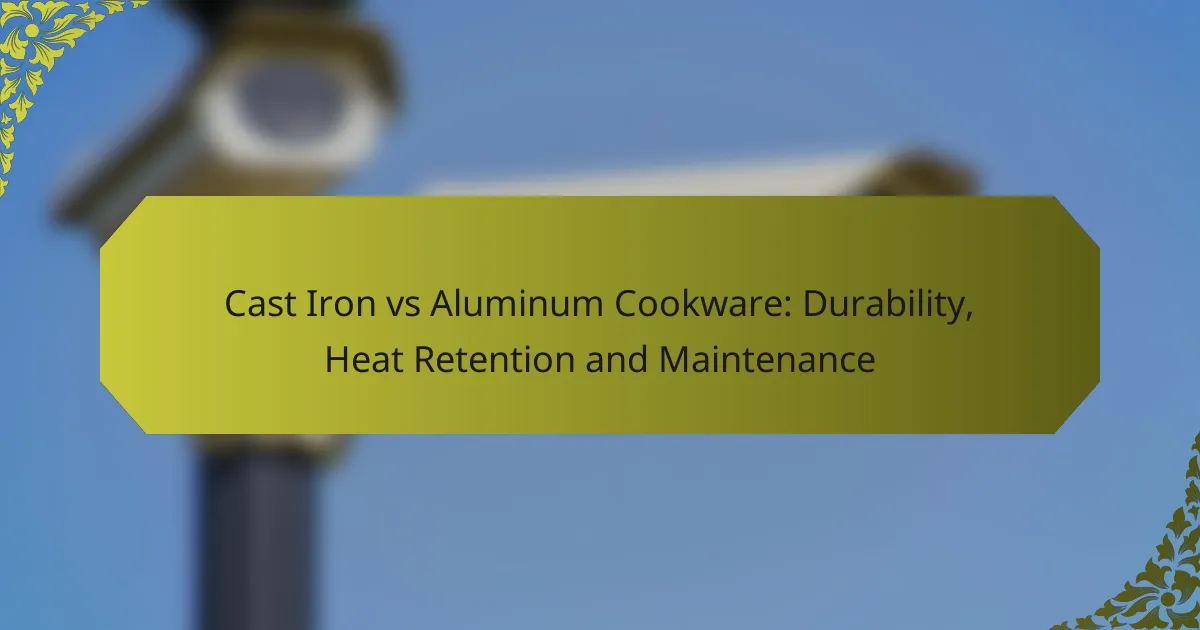Material quality plays a crucial role in cooking performance, impacting heat distribution, durability, and food release properties. Selecting the right cookware can not only enhance efficiency but also elevate the flavors of your dishes, making it vital to understand the unique characteristics of various materials. From copper to enameled cast iron and stainless steel, each option offers distinct advantages that can significantly influence your culinary outcomes.

How does material quality impact cooking performance?
Material quality significantly affects cooking performance by influencing heat distribution, durability, and food release properties. Choosing the right cookware material can enhance flavor and efficiency, making it essential to understand the characteristics of each type.
Heat conductivity of stainless steel
Stainless steel is known for its excellent heat conductivity, allowing for even cooking and browning. This material often incorporates aluminum or copper layers to enhance its thermal performance, making it ideal for tasks like sautéing and searing.
When selecting stainless steel cookware, look for options with a thick base to improve heat retention and reduce hot spots. Brands often label their products with terms like “tri-ply” or “multi-ply,” indicating layers that enhance conductivity.
Durability of cast iron cookware
Cast iron cookware is renowned for its durability and ability to withstand high temperatures, making it a favorite for slow cooking and frying. With proper care, cast iron can last for generations, developing a natural non-stick surface over time.
However, it is heavy and requires seasoning to maintain its non-stick properties. Avoid soaking cast iron in water for extended periods, as this can lead to rusting.
Non-stick properties of ceramic coatings
Ceramic-coated cookware offers a non-stick surface that is free from PTFE and PFOA, making it a safer choice for health-conscious cooks. These coatings allow for cooking with less oil, which can enhance the flavor of dishes while reducing calorie intake.
While ceramic coatings provide easy food release, they can be less durable than traditional non-stick surfaces. It’s advisable to use silicone or wooden utensils to prevent scratching and extend the lifespan of the coating.
Impact of aluminum on cooking efficiency
Aluminum cookware is lightweight and has excellent heat conductivity, which can lead to faster cooking times. This material is often anodized to prevent reactions with acidic foods, making it versatile for various cooking methods.
However, uncoated aluminum can react with certain ingredients, affecting flavor. For best results, consider using anodized or non-stick aluminum options when preparing acidic dishes like tomato sauce.
Comparison of material heat retention
Heat retention varies significantly among cookware materials, impacting how long food stays warm after cooking. Cast iron retains heat exceptionally well, making it ideal for dishes that require prolonged cooking or serving.
In contrast, stainless steel and aluminum lose heat more quickly, which can be advantageous for tasks that require temperature control. When choosing cookware, consider how heat retention aligns with your cooking style and the types of dishes you prepare.

What are the best materials for flavor enhancement?
The best materials for flavor enhancement in cooking include copper, enameled cast iron, and stainless steel. Each material has unique properties that can significantly influence the taste and quality of your dishes.
Benefits of using copper cookware
Copper cookware is renowned for its excellent thermal conductivity, allowing for precise temperature control. This responsiveness helps in achieving perfect sears and delicate sauces, enhancing the overall flavor of the food.
Additionally, copper can react with certain ingredients, such as acidic foods, which can alter flavors. To mitigate this, many copper pots are lined with stainless steel or tin, preserving the taste while benefiting from copper’s heat distribution.
Flavor retention in enameled cast iron
Enameled cast iron cookware excels in flavor retention due to its heavy construction and ability to maintain even heat. This results in slow, consistent cooking that helps develop rich flavors in stews and braises.
The enamel coating prevents reactions with food, allowing for the purest taste experience. It is ideal for long cooking times, making it a favorite for recipes that require depth of flavor.
Impact of stainless steel on food taste
Stainless steel cookware is neutral and does not react with food, ensuring that the original flavors are preserved. This makes it a versatile choice for a wide range of cooking methods, from sautéing to boiling.
While it may not conduct heat as efficiently as copper, high-quality stainless steel often features a core of aluminum or copper, enhancing heat distribution. This combination allows for better browning and flavor development without altering the taste of the ingredients.

How to choose cookware based on material quality?
Choosing cookware based on material quality involves understanding how different materials affect cooking performance and flavor. Key factors include heat conductivity, reactivity with food, and durability, all of which can significantly influence your culinary results.
Factors to consider for home chefs
Home chefs should prioritize heat conductivity and reactivity when selecting cookware materials. For instance, materials like copper and aluminum heat quickly and evenly, making them ideal for precise cooking. However, they may react with acidic foods, which can alter flavors.
Durability is another crucial factor. Stainless steel and cast iron are known for their longevity, while non-stick coatings may require more careful handling to avoid scratches. Consider your cooking style and how often you plan to use each piece of cookware.
Material compatibility with different cooking methods
Different cooking methods require specific cookware materials for optimal performance. For high-heat methods like searing, stainless steel or cast iron is preferred due to their ability to withstand high temperatures without warping.
For low-heat cooking or simmering, non-stick pans are suitable as they prevent food from sticking and allow for easy cleanup. However, avoid using metal utensils on non-stick surfaces to prolong their lifespan.
Cost vs. performance analysis
When analyzing cost versus performance, consider that higher-quality materials often lead to better cooking results and longer-lasting products. While a good stainless steel pan may cost more upfront, its durability and heat retention can save money over time.
On the other hand, budget options like aluminum or non-stick cookware can be effective for beginners or occasional cooks. Just be aware that they may need replacement more frequently, which can add to long-term costs.

What are the top brands for high-quality cookware?
The top brands for high-quality cookware include All-Clad, Le Creuset, and Scanpan. Each brand is known for its unique materials and cooking performance, making them popular choices among both home cooks and professional chefs.
All-Clad stainless steel cookware
All-Clad is renowned for its stainless steel cookware, which features a bonded construction that enhances heat distribution. This ensures even cooking and excellent browning, making it ideal for searing and sautéing.
When selecting All-Clad, consider the different collections available, such as D3 and D5, which vary in thickness and heat conductivity. Proper care, including hand washing and avoiding metal utensils, can prolong the lifespan of your cookware.
Le Creuset cast iron products
Le Creuset is famous for its enameled cast iron cookware, which excels in heat retention and even cooking. This makes it perfect for slow-cooking, braising, and baking, allowing flavors to develop beautifully.
Choose from a variety of vibrant colors and sizes to suit your kitchen style. While Le Creuset products can be more expensive, their durability and performance often justify the investment. Regular seasoning and avoiding high heat can help maintain the enamel finish.
Scanpan non-stick options
Scanpan offers high-quality non-stick cookware that is both durable and environmentally friendly. Their patented ceramic-titanium surface provides excellent non-stick properties without the use of harmful chemicals.
When using Scanpan, avoid metal utensils and high heat to preserve the non-stick surface. This cookware is ideal for low-fat cooking and easy cleanup, making it a practical choice for everyday meals.

How does maintenance affect cookware performance?
Maintenance plays a crucial role in cookware performance by ensuring that materials retain their cooking properties and enhance flavor. Proper care can extend the lifespan of cookware, improve heat distribution, and prevent food from sticking.
Cleaning techniques for different materials
Different cookware materials require specific cleaning techniques to maintain their performance. For stainless steel, a mixture of vinegar and baking soda can effectively remove stains without scratching the surface. Non-stick pans should be cleaned with a soft sponge and mild detergent to avoid damaging the coating.
Cast iron requires a different approach; it should be scrubbed with a stiff brush and hot water, avoiding soap unless absolutely necessary. For copper cookware, a paste of lemon juice and salt can restore shine while being gentle on the metal.
Seasoning cast iron for optimal flavor
Seasoning cast iron is essential for enhancing flavor and preventing rust. This process involves applying a thin layer of oil to the surface and heating it until the oil polymerizes, creating a non-stick layer. Flaxseed oil or vegetable oil are popular choices for seasoning due to their high smoke points.
To maintain the seasoning, avoid soaking the pan in water and instead wipe it clean with a cloth after use. Regularly reapplying oil after cooking can help preserve the seasoning and improve the flavor of dishes prepared in the skillet.
Impact of wear and tear on cooking quality
Wear and tear can significantly affect cooking quality by altering heat distribution and food release properties. Scratches on non-stick surfaces can lead to food sticking and uneven cooking, while worn-out seasoning on cast iron can result in rust and flavor loss.
To mitigate these issues, inspect cookware regularly for signs of damage. If a non-stick pan shows significant wear, consider replacing it to ensure optimal cooking performance. For cast iron, re-seasoning can restore its functionality, but if the surface is deeply pitted, it may be time for a new piece.

What are the emerging trends in cookware materials?
Emerging trends in cookware materials focus on sustainability, non-toxic coatings, and enhanced cooking performance. Innovations include ceramic, recycled metals, and advanced composites that improve heat distribution and durability while minimizing environmental impact.
Eco-friendly materials
Eco-friendly cookware materials are gaining popularity as consumers become more environmentally conscious. Options like ceramic, bamboo, and recycled metals reduce reliance on non-renewable resources and often feature non-toxic coatings that are safer for food preparation.
When choosing eco-friendly cookware, look for certifications such as the Green Seal or similar eco-labels that indicate sustainable practices. Brands are increasingly transparent about their sourcing and manufacturing processes, making it easier to make informed choices.
Non-toxic coatings
Non-toxic coatings are essential for ensuring safe cooking experiences. Traditional non-stick coatings often contain harmful chemicals, but newer alternatives like ceramic and silicone-based coatings provide excellent performance without releasing toxic substances at high temperatures.
When selecting non-toxic cookware, consider options that are PFOA-free and PFOS-free. It’s also wise to check for scratch resistance, as durability affects the longevity of the coating and overall safety.
Advanced heat distribution
Advanced heat distribution technologies enhance cooking performance by ensuring even heat across the cooking surface. Materials such as anodized aluminum and copper composites are popular for their superior thermal conductivity, allowing for precise temperature control.
For optimal cooking results, choose cookware that combines materials for better heat retention and distribution. For instance, stainless steel with an aluminum core can provide the benefits of both durability and efficient heat conduction.
Durability and longevity
Durability is a key consideration when selecting cookware materials, as high-quality options can withstand the rigors of daily use. Materials like cast iron and stainless steel are known for their longevity, often lasting for decades with proper care.
To maximize the lifespan of your cookware, avoid using metal utensils on non-stick surfaces and follow manufacturer cleaning guidelines. Investing in durable cookware may have a higher upfront cost but can save money in the long run by reducing the need for replacements.


